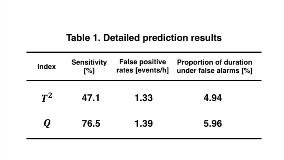Generalized Epileptic Seizure Prediction Based on Heart Rate Variability Analysis and Discussion on Its Mechanism
Abstract number :
1.121
Submission category :
2. Translational Research / 2E. Other
Year :
2018
Submission ID :
501317
Source :
www.aesnet.org
Presentation date :
12/1/2018 6:00:00 PM
Published date :
Nov 5, 2018, 18:00 PM
Authors :
Fumiya Sakane, Kyoto University; Koichi Fujiwara, Kyoto University; Miho Miyajima, Tokyo Medical and Dental University; Yoko Suzuki, Tsukuba University; Toshitaka Yamakawa, Kumamoto University; Manabu Kano, Kyoto University; and Taketoshi Maehara, Graduat
Rationale: Quality of life in patients with refractory epilepsy would be improved by epileptic seizure prediction. Based on a report that the autonomic nervous system (ANS) may be affected by abnormal epileptic discharge prior to a clinical seizure symptom, Fujiwara et al. (2016) developed a method for predicting focal seizures by combining heart rate variability (HRV) analysis and multivariate statistical process control (MSPC) which is a famous anomaly detection technique used in process control. However, generalized seizure prediction based on HRV has not been attempted. This work aims to predict generalized seizures using the Fujiwara algorithm, and to discuss the relationship between changes in HRV and a generalized seizure. Methods: We collected ECG data from 11 patients with generalized epilepsy by using a long-term video-EEG monitoring system. The collected clinical ECG datasets consist of 17 pre-ictal and 74 inter-ictal episodes. The data collection and analysis were approved by the Research Ethics Committees of the Tokyo Medical and Dental University Hospital. Six HRV features (Mean NN, RMSSD, SDNN, NN50, Total Power, LF/HF) reflecting fluctuation of the RR interval (RRI) were calculated from the collected ECG data. These HRV features were monitored by the MSPC-based epileptic seizure prediction algorithm with the T2 and Q statistics. The algorithm discriminates the patient state, ‘inter-ictal’ and ‘pre-ictal’, in which ‘pre-ictal’ means a seizure will occur in the near future. A total of 12.4 hours in 18 inter-ictal episodes were used for modeling and the rest were used for validation. The control limits of the T2 and Q statistics were determined for every patient so that they represented the 95% confidence limits. When either T2 or Q statistic exceeds its control limit for more than 15 seconds continuously, the patient state is regarded as ‘pre-ictal’. Results: The application results to the clinical datasets are shown in Table 1. Application examples of inter-ictal and pre-ictal episodes of a patient are shown in Fig. 1. The analysis results demonstrated a possibility that generalized seizures may be predicted prior to seizure onsets by monitoring HRV. Based on the previous researches and our analysis results, we hypothesize that the changes in the ANS induce generalized seizures. This hypothesis might be consistent with the analysis results in that autonomic changes do not always occur immediately before seizure onsets, as is shown in Fig. 1. However, further studies are needed for confirming our results. Conclusions: Our analysis results suggested that generalized seizures may be predicted by using HRV features, and we hypothesized that generalized seizures are induced by changes in the ANS. In the future work, we will collect additional clinical data for validating our analysis result and improving the performance of the seizure prediction algorithm. Funding: JSPS KAKENHI Grant Number JP25282175, AMED SENTAN 171122, the Hattori Hokokai Foundation, the SECOM Science and Technology Foundation, and the Murata Science Foundation

.tmb-.jpg?Culture=en&sfvrsn=becbece3_0)